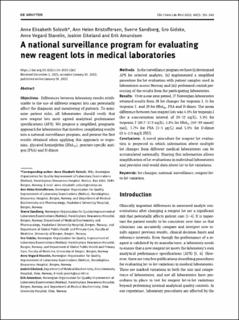A national surveillance program for evaluating new reagent lots in medical laboratories
Solsvik, Anne Elisabeth; Kristoffersen, Ann-Helen; Sandberg, Sverre; Gidske, Gro; Stavelin, Anne; Eikeland, Joakim; Amundsen, Erik Koldberg
Journal article, Peer reviewed
Published version

Åpne
Permanent lenke
https://hdl.handle.net/11250/3063811Utgivelsesdato
2022Metadata
Vis full innførselSamlinger
Originalversjon
Clinical Chemistry and Laboratory Medicine. 2022, 60 (3), 351-360. 10.1515/cclm-2021-1262Sammendrag
Objectives Differences between laboratory results attributable to the use of different reagent lots can potentially affect the diagnosis and monitoring of patients. To minimize patient risks, all laboratories should verify that new reagent lots meet agreed analytical performance specifications (APS). We propose a simplified, pragmatic approach for laboratories that involves compilating results into a national surveillance program, and present the first results obtained when applying this approach to troponins, glycated hemoglobin (HbA1c), prostate-specific antigen (PSA) and D-dimer. Methods In the surveillance program we have (i) determined APS for selected analytes, (ii) implemented a simplified procedure for lot evaluation with patient samples used in laboratories across Norway and (iii) performed central processing of the results from the participating laboratories. Results Over a one-year period, 27 Norwegian laboratories returned results from 28 lot changes for troponin I, 11 for troponin T, and 29 for HbA1c, PSA and D-dimer. The mean difference between two reagent lots was 4.5% for troponin I (for a concentration interval of 20–32 ng/L), 5.1% for troponin T (10.7–17.5 ng/L), 2.2% for HbA1c (40–50 mmol/mol), 3.7% for PSA (3–5 μg/L) and 5.5% for D-dimer (0.4–1.0 mg/L FEU). Conclusions A novel procedure for reagent lot evaluation is proposed in which information about multiple lot changes from different medical laboratories can be accumulated nationally. Sharing this information allows simplification of lot evaluations in individual laboratories and provides real-world data about lot-to-lot variations.